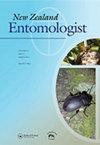新西兰尖桉(Eucolaspis Sharp)、尖毛茛(Atrichatus Sharp)的分类、分布及E. kotatou sp. nov.描述(鞘翅目:金蝇科,金蝇科)
IF 0.4
4区 农林科学
Q4 ENTOMOLOGY
引用次数: 2
摘要
来自新西兰的真毛猴科(鞘翅目:金毛猴科)在物种多样性方面所知甚少,从逻辑上讲,对物种特征的任何下游理解,包括物种分布或生态学。这是事实,尽管其中一些物种已被认为是农业害虫,并与该国的经济损失有关。在这项工作中,我分析了在20世纪50年代曾被分类修订的两个属的多样性和分布,即Atrichatus Sharp和Eucolaspis Sharp。我的观察,基于相对丰富的材料,从三个收集和新收集的标本,大致同意该工作的结论,确定了2种非洲和至少5种桉树。我提供了一个新的分类特征,即所有物种的精囊描述,以及基于现有收集数据的精细分布图。报道了一种桉树新种,E. kotatou sp. nov.,产自北领地雷因加角附近的巴基。此外,在罗托鲁瓦(丰盛湾)报告了E. antennata Shaw,以前只从两个标本中知道,没有地方数据。尽管有松散的相似性,但主要分布在南岛北部的阿利卡塔斯和与阿利卡塔斯大致相同,但更多样化和广泛分布在北岛的Eucolaspis不应被视为近亲,这是基于euumolpinae高级系统学的一个重要诊断特征,即pygidium上的背槽,前者存在,后者缺乏。http://www.zoobank.org/urn:lsid:zoobank.org:act:05CCCC7C-E8DE-41F3-B0D1-F2090D79754B本文章由计算机程序翻译,如有差异,请以英文原文为准。
Comments on the taxonomy and distribution of Eucolaspis Sharp and Atrichatus Sharp in New Zealand and description of E. kotatou sp. nov. (Coleoptera: Chrysomelidae, Eumolpinae)
ABSTRACT The Eumolpinae (Coleoptera: Chrysomelidae) from New Zealand are poorly known in terms of species diversity and, logically, of any downstream understanding of species features, including species distribution or ecology. This is true even though some of the species have been recognised as agricultural pests and associated with economic losses in the country. In this work, I have analysed the diversity and distribution of two genera of Eumolpinae that had been the subject of a taxonomic revision in the 1950s, Atrichatus Sharp and Eucolaspis Sharp. My observations, based on relatively abundant material from three collections and newly collected specimens, generally agree with the conclusions of that work, identifying two species of Atrichatus and at least five of Eucolaspis. I provide a new taxonomic character, namely the description of the spermathecae of all the species, as well as refined distribution maps based on available collection data. One new species of Eucolaspis is described, E. kotatou sp. nov., from Te Paki, near Cape Reinga (Northland). In addition, E. antennata Shaw, previously known from only two specimens without locality data, is reported from Rotorua (Bay of Plenty). Despite loose similarities, Atrichatus – mainly distributed in the north of the South Island – and Eucolaspis – broadly sympatric with Atrichatus, but more diverse and widely distributed in the North Island – should not be considered as close relatives based on an important diagnostic character for higher-level systematics of Eumolpinae, namely a dorsal groove on the pygidium, present in the former and lacking in the latter. http://www.zoobank.org/urn:lsid:zoobank.org:act:05CCCC7C-E8DE-41F3-B0D1-F2090D79754B
求助全文
通过发布文献求助,成功后即可免费获取论文全文。
去求助
来源期刊

New Zealand Entomologist
ENTOMOLOGY-
CiteScore
0.70
自引率
33.30%
发文量
3
审稿时长
>12 weeks
期刊介绍:
The invertebrate diversity of New Zealand is of great interest worldwide because of its geographic isolation and geological history. The New Zealand Entomologist plays an important role in disseminating information on field-based, experimental, and theoretical research.
The New Zealand Entomologist publishes original research papers, review papers and short communications. We welcome submissions in all aspects of science regarding insects and arthropods in a New Zealand or Australasian setting. The journal’s subject matter encompasses taxonomy, phylogenetics, biogeography, biological control and pest management, conservation, ecology and natural history.
The journal is the official publication of the Entomological Society of New Zealand. Papers published or submitted elsewhere for publication will not be considered, but publication of an abstract or summary elsewhere (e.g. conference proceedings) does not preclude full publication in the New Zealand Entomologist. Accepted papers become copyright of the Entomological Society of New Zealand. The journal is published in English, but we also welcome publication of abstracts in Maori.
 求助内容:
求助内容: 应助结果提醒方式:
应助结果提醒方式:


